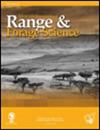津巴布韦半干旱小农农业系统中的山羊饲料和饲养方法
IF 1.9
4区 环境科学与生态学
Q3 ECOLOGY
引用次数: 2
摘要
本研究旨在确定津巴布韦半干旱地区小农可利用的山羊饲料资源。采用生态牧场评价与参与式研究相结合的方法,确定了北桥区Chamunangana和Joko两个区饲料资源的多样性。调查了120个家庭。所有农民都以牧场为主要饲料来源。约87%的受访者表示牧场不足,但只有54%的人采取了补充措施。参与者主要使用作物残茬(40%),浏览树叶(28%)和商业饲料(22%)作为补充。在46%没有使用补充剂的人中,53%的人认为这是因为无法获得喂养材料,29%的人没有意识到这一点的重要性,而其余的人则认为没有必要。Chamunangana的农民和给山羊挤奶的农民更有可能补充饲料(p < 0.05)。补充组接受过山羊养殖培训(p < 0.05)。Chamunangana的Shannon-Wiener多样性指数(H’)为1.29,高于Joko的1.19。各试验点间生物量产量无显著差异(p > 0.05)。通过对农民进行山羊养殖培训并将现有饲料纳入均衡的口粮,可以改善山羊的营养状况。本文章由计算机程序翻译,如有差异,请以英文原文为准。
Goat feeds and feeding practises in a semi-arid smallholder farming system in Zimbabwe
This study was conducted to identify the available goat feed resources for smallholder farmers in the semi-arid region of Zimbabwe. An ecological rangeland assessment was combined with participatory research methods to determine the diversity of feed resources in two wards of the Beitbridge District, namely Chamunangana and Joko. One hundred and twenty households were surveyed. All farmers depended on rangeland as the main feed resource. Some 87% of the respondents indicated that rangeland was not adequate, yet only 54% practiced supplementation. Participants predominantly used crop residues (40%), browse tree foliage (28%) and commercial feeds (22%) as supplements. Of the 46% who did not apply supplements, 53% attributed this to unavailability of feeding material and 29% were not aware of the importance, whereas the rest thought it unnecessary. Farmers in Chamunangana and those who milked their goats were more likely to supplement feed (p < 0.05). Respondents who supplemented had received training in goat husbandry (p < 0.05). The Shannon–Wiener diversity index (H′) was higher in Chamunangana (1.29), compared with Joko (1.19). There was no difference in biomass production between the study sites (p > 0.05). Improved goat nutrition could be achieved through farmer trainings in goat husbandry and incorporating available feeds into balanced rations.
求助全文
通过发布文献求助,成功后即可免费获取论文全文。
去求助
来源期刊

African Journal of Range & Forage Science
ECOLOGY-ENVIRONMENTAL SCIENCES
CiteScore
4.00
自引率
14.30%
发文量
35
审稿时长
>12 weeks
期刊介绍:
The African Journal of Range & Forage Science is the leading rangeland and pastoral journal in Africa. The Journal is dedicated to publishing quality original material that advances rangeland ecology and pasture management. The journal aims to publish research of international importance from any region, but as an African journal, we are particularly interested in research from Africa and relevant to the continent. The Journal promotes both science and its application and authors are encouraged to explicitly identify the practical implications of their work. Peer-reviewed research papers and research notes deal primarily with all aspects of rangeland and pasture ecology and management, including the ecophysiology and biogeochemistry of rangelands and pastures, terrestrial plant–herbivore interactions (both domestic and wild), rangeland assessment and monitoring, effects of climate change on rangelands, rangeland and pasture management, rangeland rehabilitation, ecosystem services in support of production, conservation and biodiversity goals, and the identification and development of intensive and semi-intensive pasture and forage resources to meet livestock production needs. Articles highlighting transdisciplinary linkages among biophysical and social sciences that support management, policy and societal values are particularly encouraged. The Journal includes relevant book reviews and invited perspectives that contribute to the development of range and forage science. Letters to the editor that debate issues raised in the Journal are acceptable. The African Journal of Range & Forage Science is the official journal of the Grassland Society of Southern Africa.
 求助内容:
求助内容: 应助结果提醒方式:
应助结果提醒方式:


